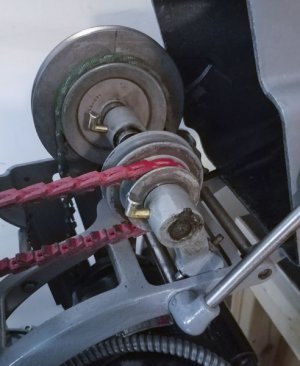- Joined
- Dec 12, 2014
- Messages
- 261
Let me put as much info as I can to solve what should be a simple problem.
Atlas MFB
Cutting mild steel
Using 1/2" end mill (because I don't have the original arbor...yet.)
Each pass I raise the knee (Y axis, correct?) to a depth of cut set for .010" - .015" and my Z axis(parallel direction to the spindle) is always set to .125" cut.
Tried all of the various back gear speeds (160? rpm(can't recall the setting at the moment) and 440 rpm)
Tried table feed set at .006" and .003"
I've adjusted the countershaft screws for the pulleys to the point just beyond where the belt will slip as I don't want to burn up the belt. The problem then is that I can't take but the tiniest of cuts without the belt actually slipping. So, I tried tightening the belt so I can actually take a cut. But then the countershaft bearing heats up real hot, like 150º hot measured with a infrared laser thermometer.
I checked the alignment of the countershaft pulley in relationship with the spindle pulley using a straight piece of square stock and it checked out fine. Of course, the heat is being transferred through the pulley to the spindle which measured much cooler but still hot for my liking. 90º on the spindle pulley.
Everything is oiled with Mobil Velocite #6 spindle oil.
My thoughts, just buy a new belt after work to eliminate that variable. I'm probably overthinking all of this, right?
This all got me thinking, what's the average depth of cut that one can expect from this machine using an end mill. I know that question has alot of variables like material being cut, type of cutter, etc. Just trying to learn this new to me machine.
Pic of what I'm talking about for clarity. The front pulley/bearing are the hot spot.

Atlas MFB
Cutting mild steel
Using 1/2" end mill (because I don't have the original arbor...yet.)
Each pass I raise the knee (Y axis, correct?) to a depth of cut set for .010" - .015" and my Z axis(parallel direction to the spindle) is always set to .125" cut.
Tried all of the various back gear speeds (160? rpm(can't recall the setting at the moment) and 440 rpm)
Tried table feed set at .006" and .003"
I've adjusted the countershaft screws for the pulleys to the point just beyond where the belt will slip as I don't want to burn up the belt. The problem then is that I can't take but the tiniest of cuts without the belt actually slipping. So, I tried tightening the belt so I can actually take a cut. But then the countershaft bearing heats up real hot, like 150º hot measured with a infrared laser thermometer.
I checked the alignment of the countershaft pulley in relationship with the spindle pulley using a straight piece of square stock and it checked out fine. Of course, the heat is being transferred through the pulley to the spindle which measured much cooler but still hot for my liking. 90º on the spindle pulley.
Everything is oiled with Mobil Velocite #6 spindle oil.
My thoughts, just buy a new belt after work to eliminate that variable. I'm probably overthinking all of this, right?
This all got me thinking, what's the average depth of cut that one can expect from this machine using an end mill. I know that question has alot of variables like material being cut, type of cutter, etc. Just trying to learn this new to me machine.
Pic of what I'm talking about for clarity. The front pulley/bearing are the hot spot.

